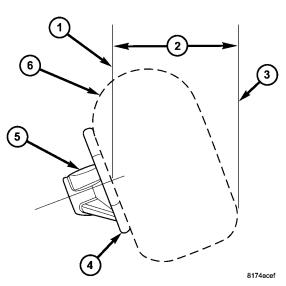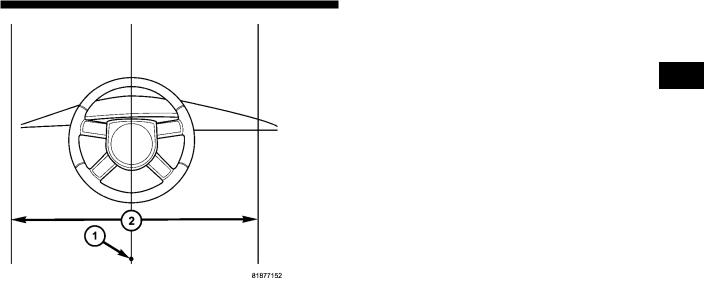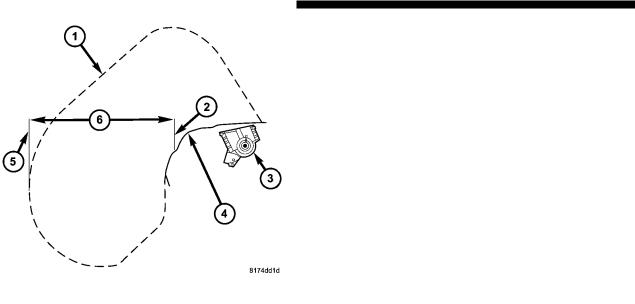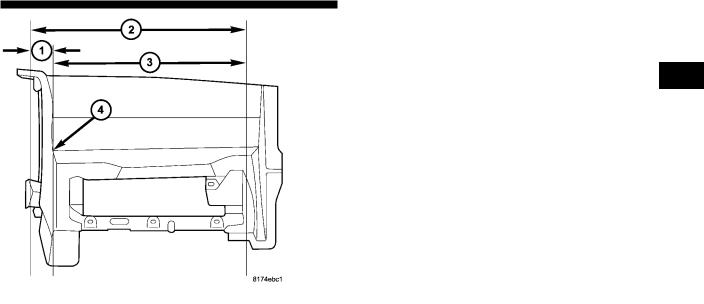Dodge CHARGER POLICE Owner Manual

2 0 1 1 Charger
O W N E R ’ S M A N UA L
POLICE SUPPLEMENT

VEHICLES SOLD IN CANADA
With respect to any Vehicles Sold in Canada, the name Chrysler Group LLC shall be deemed to be deleted and the name Chrysler Canada Inc. used in substitution therefore.
DRIVING AND ALCOHOL
Drunken driving is one of the most frequent causes of accidents.
Your driving ability can be seriously impaired with blood alcohol levels far below the legal minimum. If you are drinking, don’t drive. Ride with a designated non-drinking driver, call a cab, a friend, or use public transportation.
WARNING!
Driving after drinking can lead to an accident. Your perceptions are less sharp, your reflexes are slower, and your judgment is impaired when you have been drinking. Never drink and then drive.
This manual illustrates and describes the operation of features and equipment that are either standard or optional on this vehicle. This manual may also include a description of features and equipment that are no longer available or were not ordered on this vehicle. Please disregard any features and equipment described in this manual that are not on this vehicle.
Chrysler Group LLC reserves the right to make changes in design and specifications, and/or make additions to or improvements to its products without imposing any obligation upon itself to install them on products previously manufactured.
Copyright © 2010 Chrysler Group LLC

SECTION
TABLE OF CONTENTS
PAGE
1
2
3
4
5
6
7
8
. . . . . . . . . . . . . . . . . . . . . . . . . . . . . . . . . . . . . . . . . . . . . . . . . . . . . . . . . . .INTRODUCTION |
. 3 |
1 |
|
|
|
THINGS TO KNOW BEFORE STARTING YOUR VEHICLE . . . . . . . . . . . . . . . . . . . . . . . . . . . . . |
.5 |
2 |
|
|
|
UNDERSTANDING THE FEATURES OF YOUR VEHICLE . . . . . . . . . . . . . . . . . . . . . . . . . . . . . |
19 |
3 |
|
|
|
UNDERSTANDING YOUR INSTRUMENT PANEL . . . . . . . . . . . . . . . . . . . . . . . . . . . . . . . . . . . |
29 |
4 |
|
|
|
STARTING AND OPERATING . . . . . . . . . . . . . . . . . . . . . . . . . . . . . . . . . . . . . . . . . . . . . . . . . |
31 |
5 |
WHAT TO DO IN EMERGENCIES . . . . . . . . . . . . . . . . . . . . . . . . . . . . . . . . . . . . . . . . . . . . . . |
37 |
6 |
|
|
|
MAINTAINING YOUR VEHICLE . . . . . . . . . . . . . . . . . . . . . . . . . . . . . . . . . . . . . . . . . . . . . . . |
39 |
7 |
|
|
|
INDEX . . . . . . . . . . . . . . . . . . . . . . . . . . . . . . . . . . . . . . . . . . . . . . . . . . . . . . . . . . . . . . . . . . . . |
43 |
8 |

INTRODUCTION
1
CONTENTS
Introduction . . . . . . . . . . . . . . . . . . . . . . . . . . . |
4 |

4 INTRODUCTION
INTRODUCTION
This booklet is a supplement to the Owner’s Manual prepared with the assistance of service and engineering specialists, and is intended to aid the operators of police or fleet vehicles (used in severe duty, high-mileage operations) in understanding the operation and required maintenance procedures for such vehicles. It covers maintenance procedures for vehicles equipped with heavy-duty packages. However, other vehicles operated under the conditions listed below are also considered “severe service” vehicles, and should be serviced and maintained as prescribed in this booklet. This supplement applies to rear-wheel drive passenger cars only. You are urged to read this publication and the Owner’s Manual carefully.
Refer to the Police Upfitter’s Guide provided with your vehicle, prior to the addition of any aftermarket equipment.
Following the instructions and recommendations provided herein, will help assure safe and reliable operation of your vehicle. After you have read the booklet, it should be stored in the vehicle for convenient reference and remain with the vehicle when sold.

THINGS TO KNOW BEFORE STARTING YOUR VEHICLE
CONTENTS |
|
|
|
2 |
|
|
|
|
|
Modified Rear Door – Locks, Levers, And |
▫ Airbag Deployment Zones . . . . . . . . . . . . . . . . |
8 |
|
|
Window Switches — If Equipped . . . . . . . . . . . . . |
6 |
|
|
|
Occupant Restraints . . . . . . . . . . . . . . . . . . . . . . |
7 |
|
|
|

6 THINGS TO KNOW BEFORE STARTING YOUR VEHICLE
MODIFIED REAR DOOR – LOCKS, LEVERS, AND WINDOW SWITCHES — IF EQUIPPED
The emergency rear door lock knob is located on the front portion of each rear door panel, visible when the front door is opened. Pull the knob out to unlock the door. The rear doors can be locked from the outside of the vehicle by pushing the knob in.
Both rear passenger doors are inoperable from the rear seat position, inside of the vehicle. There are three ways to operate the rear door locks:
•The emergency rear door lock knob on the front portion of each rear door panel
•Either front door lock switch
•The remote keyless entry transmitter
The rear windows are inoperable from the rear door switches. Rear windows are only operable by the driver door master switch.
Emergency Door Lock Knob

OCCUPANT RESTRAINTS
Driver/passenger airbags affect the way police equipment can be safely mounted in police vehicles.
Any surface that could come into contact with an airbag, once it has been deployed, must not damage the airbag or alter its deployment path.
The addition of the supplemental equipment (such as radios, weapons, mounting brackets, cage, etc.), must be installed such that it will not interfere or come in contact with a deploying airbag. Airbag deployment zones are described below. Sharp edges, corners or protrusions on supplemental equipment, could damage the nylon airbag material and reduce the effectiveness of the airbag during a deployment.
THINGS TO KNOW BEFORE STARTING YOUR VEHICLE 7
WARNING!
• Vehicles equipped with left and right-side curtain airbags must use police cages, which have been 2 approved by the equipment manufacturer, for use
in the vehicle.
•The area where the side-curtain airbag is located should remain free from any obstructions.
•If your vehicle is equipped with left and right side curtain airbags, care must be taken when installing any type of roof equipment. Drilling and installation of fasteners or other equipment that may interfere with the side-curtain airbags and airbag wiring harness, is not permitted. Furthermore, make sure that no equipment or fasteners are located in the airbag deployment zone.
(Continued)

8 THINGS TO KNOW BEFORE STARTING YOUR VEHICLE
WARNING! (Continued)
•Do not place objects or mount equipment in front of the airbag module cover, or in front of the seat areas that may come in contact with a deploying airbag.
•Dash, tunnel or console-mounted equipment should not be placed outside of the specified zone.
•Failure to follow these instructions could result in personal injury.
Airbag Deployment Zones
There are four zones to be aware of:
1.Driver Airbag Deployment Zone (Fig. 1), and Driver Airbag/Steering Wheel Specifications (Fig. 2)
2.Passenger Airbag Deployment Zone (Fig. 3) and (Fig.
4)
3.Side-Curtain Airbag Deployment Zone (Fig. 5)
4.Seat-Mounted Airbag Deployment Zone (Fig. 6)

|
THINGS TO KNOW BEFORE STARTING YOUR VEHICLE |
9 |
|
|
|
|
|||
Figure 1 - Driver Airbag Deployment Zone, depicts the |
||||
following. |
|
|
||
1. Vertical Plane Passing Through Center of Steering |
|
|||
2 |
||||
Wheel |
|
|||
2.18.5 in (47 cm)
3.Vertical Plane Passing Through Maximum Rearward Point that the Driver Airbag Cushion Reaches
4.Steering Wheel
5.Driver Airbag Retainer/Housing
6.Driver Airbag Cushion
Figure 1

10 THINGS TO KNOW BEFORE STARTING YOUR VEHICLE
DRIVER AIRBAG/STEERING COLUMN SPECIFICATIONS
DRIVER AIRBAG CUSHION POSITION
DAB Diameter When De-
26.5 in (67 cm)
ployed (Full)
DAB Depth When De-
15 in (38 cm)
ployed (Full)
Maximum Rearward Dis-
placement During De18.5 in (47 cm) ployment (Fill)
STEERING COLUMN TILT POSITION RANGE
+/– 2.7 Degrees from Steering Column Tilt Pivot Point
21.0 Degrees from Vertical is the Nominal Position

THINGS TO KNOW BEFORE STARTING YOUR VEHICLE 11
Figure 2 - Driver Airbag Lateral Deployment Zone, depicts the following.
1. Driver Seating Reference
2
2. Driver Airbag Cushion Lateral Deployment Zone,
28 in (71 cm).
Figure 2

12 THINGS TO KNOW BEFORE STARTING YOUR VEHICLE
Figure 3 - Passenger Airbag Deployment Zone, depicts the following.
1. Passenger Airbag Cushion
2. Vertical Plane from Point of Instrument Panel
3. Passenger Airbag Module
4. Instrument Panel
5. Vertical Plane Passing Through the Maximum Rearward Point that the Passenger Airbag Cushion Reaches
6. 18.5 in (47 cm)
Figure 3

THINGS TO KNOW BEFORE STARTING YOUR VEHICLE 13
Figure 4 - Passenger Airbag Lateral Deployment Zone, depicts the following.
1. 2.75 in (7 cm)
2
2.Passenger Airbag Cushion Deployment Zone
3.20 in (52 cm)
4.Reference Point
Figure 4
